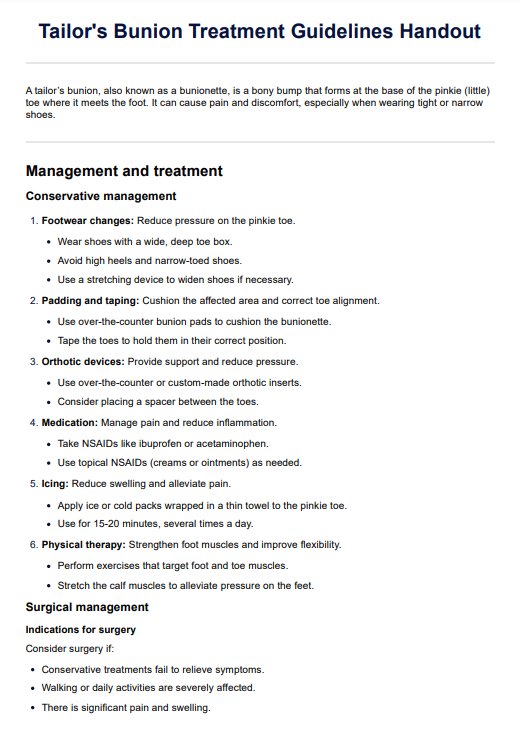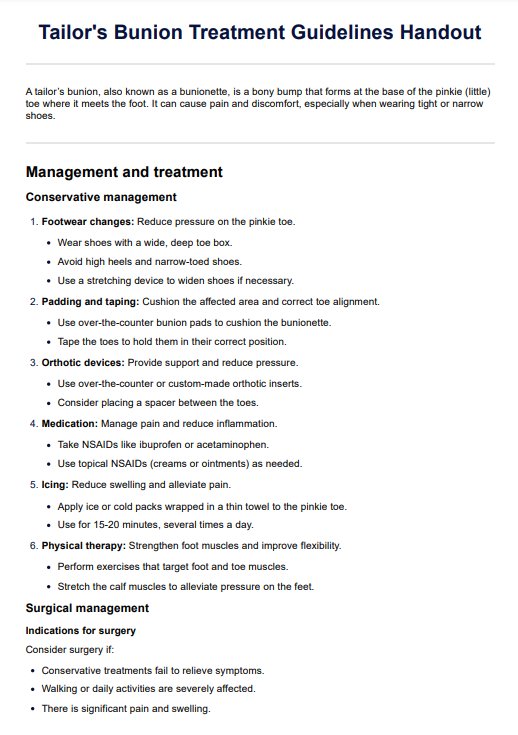Tailor's Bunion Treatment Guidelines Handout
Discover effective treatment guidelines for tailor's bunion. Improve patient outcomes with our comprehensive template. Download the free guide for healthcare professionals now!


What is a tailor's bunion?
Tailor’s bunion, also known as bunionette, is a deformity characterized by a bony prominence on the outer side of the fifth metatarsal head, near the base of the little toe. In contrast, regular bunions grow inside the foot below the big toe. This condition is named after tailors who used to sit cross-legged, which caused pressure on the outside of their feet.
Causes
The primary causes of a tailor's bunion include genetic predisposition, abnormal foot mechanics, and improper footwear. Having loose ligaments or a family history of bunions or other foot deformities increases the likelihood of developing a tailor's bunion. Abnormal foot mechanics, such as overpronation or having an inverted foot, can also contribute to the development of this condition. Wearing tight, narrow, or high-heeled shoes can exacerbate the symptoms by putting additional pressure on the affected area.
Symptoms
Common symptoms of tailor’s bunion include pain, swelling, and redness around the bony spur. The pain typically worsens with prolonged walking or standing and when wearing tight shoes. In some cases, a callus may form over the bunionette due to continuous friction. Continuous feet rubbing can also lead to the formation of calluses.
Tailor's Bunion Treatment Guidelines Handout Template
Tailor's Bunion Treatment Guidelines Handout Example
Treatment for a tailor's bunion
Treating tailor’s bunion involves a combination of conservative and surgical approaches, depending on the severity of the symptoms and the patient’s response to initial treatments. Avoiding narrow, pointy shoes that squeeze your toes together can significantly help treat tailor's bunions. Here is an overview of the treatment guidelines provided in our comprehensive template:
Pre-operative management
Pre-operative management focuses on educating patients and implementing conservative measures to alleviate symptoms and prepare for potential surgery. Key steps include:
- Patient education: Inform patients about foot and ankle care, including the condition, treatment options, and recovery expectations.
- Footwear modifications: Advice patients to wear shoes with a wide toe box and avoid high heels and narrow-toed or pointed shoes.
- Padding and orthotics: Recommend tailor's bunion pads or custom orthotic devices to redistribute pressure.
- Medication: Suggest nonsteroidal anti-inflammatory drugs (NSAIDs) like ibuprofen or acetaminophen to manage pain and inflammation.
- Physical therapy: Encourage exercises that strengthen foot muscles and improve flexibility.
Operative treatment by a foot and ankle surgeon
Surgical intervention is considered when conservative measures fail to provide relief. The primary goals of surgery are to correct the deformity and improve the patient’s quality of life. Common surgical techniques vary depending on the severity of the bunion's deformity:
- Mild cases (Type 1): A simple exostectomy (removal of the bony lump) may be sufficient to address the problem.
- Moderate cases (Type 2): An osteotomy (cutting and realigning the fifth metatarsal bone and the little toe joint) may be performed to correct the underlying structural issues.
- Severe cases (Type 3): In severe cases, more extensive procedures like a medial midshaft or proximal wedge osteotomy may be required to significantly reposition the fifth metatarsal and restore proper foot alignment.
In addition to bony procedures, soft tissue realignment techniques may also be utilized to adjust the surrounding ligaments and tendons and improve the overall foot mechanics.
Post-operative management
Post-operative care ensures proper healing, prevents complications, and restores function. Key steps include:
- Non-weight bearing: Advise patients to avoid putting weight on the affected foot for at least six weeks.
- Immobilization: Use a modified shoe or cast to protect the surgical site.
- Edema management: Recommend elevating the foot and using ice packs to reduce swelling.
- Physiotherapy: Include gait training, strengthening exercises, and range of motion exercises.
- Pain management: Use TENS and appropriate medications to relieve pain and provide desensitizing techniques.
- Shoe selection: Recommend shoes with a wide toe box and good arch support.
How to use our treatment guidelines handout template?
Our treatment guidelines handout template for tailor's bunion is designed to provide healthcare professionals with a structured and comprehensive approach to managing this condition. Here’s how you can effectively use this template in your practice:
Step 1: Download the template
Start by downloading the treatment guidelines handout template. Ensure you have the latest version to provide your patients with the most accurate and up-to-date information.
Step 2: Familiarize yourself with the content
Review the template's content thoroughly. Familiarize yourself with the different sections, including pre-operative management, operative treatment, and post-operative management. This will help you effectively communicate the information to your patients.
Step 3: Customize the template for your practice
While the template provides comprehensive guidelines, you may need to customize certain aspects to fit the specific needs of your practice and patient population. Add any additional instructions or notes that are relevant to your treatment protocols.
Step 4: Use the template during patient consultations
Use the template as a reference guide for managing tailor's bunions during patient consultations. Walk your patients through each section, explaining the steps in managing a tailor’s bunion. Provide them with a copy of the handout for further reading and reference.
How can healthcare professionals benefit from our template?
Our tailor's bunion treatment guidelines template offers numerous advantages for healthcare professionals, providing a comprehensive and structured approach to managing this condition. Here are three key benefits:
Streamlined patient education
The template ensures that healthcare professionals can effectively educate patients about tailor's bunion, its causes, symptoms, and treatment options. Providing clear and concise information helps patients understand their condition and the importance of adhering to treatment protocols.
Enhanced treatment planning
With detailed pre-operative, operative, and post-operative management guidelines, the template aids healthcare professionals in creating personalized and effective treatment plans for their patients. This structured approach ensures all aspects of the patient's care are addressed, leading to better outcomes.
Improved patient compliance
The template offers a comprehensive treatment plan, helping patients follow through with their prescribed treatments. Clear instructions and detailed explanations make it easier for patients to comply with their care plan, ultimately improving their quality of life.
Commonly asked questions
Tailor’s bunion, also known as tailors bunion or bunionette, is a foot deformity characterized by a bony prominence on the outer side of the fifth metatarsal head, near the base of the little toe. It causes pain and discomfort, especially when wearing tight or narrow shoes. The condition is named "tailor's bunion" because it was commonly seen in tailors who sat cross-legged, putting pressure on the outside of their feet.
Common symptoms of tailor’s bunion include pain, swelling, and redness around the bony prominence. The pain typically worsens with prolonged walking or standing and when wearing tight shoes. Symptoms can also include a burning sensation and callus formation over the affected area.
Tailor’s bunion can be treated through conservative measures such as footwear modifications, wearing a silicone bunion pad, orthotics, medication, and physical therapy. If these methods fail, surgical options like osteotomy, exostectomy, and soft tissue realignment may be considered.







































































































